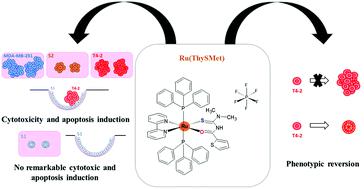当前位置:
X-MOL 学术
›
Inorg. Chem. Front.
›
论文详情
Our official English website, www.x-mol.net, welcomes your
feedback! (Note: you will need to create a separate account there.)
Three-dimensional cell culture models for metallodrug testing: induction of apoptosis and phenotypic reversion of breast cancer cells by the trans-[Ru(PPh3)2(N,N-dimethyl-N-thiophenylthioureato-k2O,S)(bipy)]PF6 complex
Inorganic Chemistry Frontiers ( IF 6.1 ) Pub Date : 2020-07-03 , DOI: 10.1039/d0qi00502a Amanda B. Becceneri 1, 2, 3, 4 , Angelina M. Fuzer 1, 2, 3, 4 , Ana M. Plutin 5, 6, 7, 8 , Alzir A. Batista 2, 3, 4, 9 , Sophie A. Lelièvre 10, 11, 12, 13 , Marcia R. Cominetti 1, 2, 3, 4
Inorganic Chemistry Frontiers ( IF 6.1 ) Pub Date : 2020-07-03 , DOI: 10.1039/d0qi00502a Amanda B. Becceneri 1, 2, 3, 4 , Angelina M. Fuzer 1, 2, 3, 4 , Ana M. Plutin 5, 6, 7, 8 , Alzir A. Batista 2, 3, 4, 9 , Sophie A. Lelièvre 10, 11, 12, 13 , Marcia R. Cominetti 1, 2, 3, 4
Affiliation

|
Many studies have revealed the advantages of using three-dimensional (3D) culture over traditional two-dimensional (2D) monolayer techniques. The 3D cell culture models represent biologically relevant approaches to better mimic the tumor organization observed in vivo. These models have high potential for anticancer drug development and screening, for which challenges include tumor cell resistance to treatment and the risk of toxicity for patients. Many anticancer drug candidates do not reach clinical trials as they fail preclinical tests in vivo, although they were promising in 2D cultures. Models from 3D cell cultures are proposed as intermediate screening filters between 2D and in vivo assays. It has been suggested that ruthenium complexes have great potential for breast cancer treatment. Here, we tested the trans-[Ru(PPh3)2(N,N-dimethyl-N-thiophenylthioureato-k2O,S)(bipy)]PF6 complex in breast cancer cell lines using different 3D culture techniques, including the embedded, ‘on top’ and disease-on-a-chip (DOC) models that reproduce physical aspects of the tumor microenvironment. The complex had pronounced but distinct cytotoxic effects on tumors cultured in collagen I of appropriate stiffness for the disease stage; the extent of induced apoptosis depends on the preinvasive (S2 cells) and invasive (T4-2 and MDA-MB-231 cells) nature of triple-negative breast cancer models. Remarkably, in the DOC model, which simulates breast ductal architecture, the complex was cytotoxic for T4-2 tumors but had no remarkable effect on the differentiated luminal epithelial S1 cells, demonstrating selectivity against cancer cells. In addition, a lower concentration of the complex abrogated the malignant phenotype of the T4-2 cells with reduction of EGFR, p50 NFκB, and β1-integrin expression. To the best of our knowledge, this work uniquely demonstrates the effects of a ruthenium complex on the induction of apoptosis and on the phenotypic reversion of tumor cells in 3D cultures. These results warrant moving to in vivo evaluation of this ruthenium complex.
中文翻译:

用于金属药物测试的三维细胞培养模型:通过反式[Ru(PPh3)2(N,N-二甲基-N-硫代苯基硫脲-k2O,S)(bipy)] PF6诱导乳腺癌细胞凋亡和表型逆转复杂
许多研究已经揭示了使用三维(3D)文化比传统的二维(2D)单层技术的优势。3D细胞培养模型代表了与生物有关的方法,可以更好地模拟体内观察到的肿瘤组织。这些模型具有开发和筛选抗癌药物的巨大潜力,面临的挑战包括肿瘤细胞对治疗的抵抗力和对患者的毒性风险。尽管许多抗癌药物候选者在2D培养中都充满希望,但由于它们在体内的临床前测试失败而未能通过临床试验。提议将3D细胞培养的模型用作2D和体内之间的中间筛选过滤器分析。已经提出钌配合物在乳腺癌治疗中具有巨大潜力。在这里,我们测试了反式-[Ru(PPh 3)2(N,N-二甲基-N-硫代苯基硫脲-k 2 O,S)(bipy)] PF 6使用不同的3D培养技术(包括嵌入的,“顶层”和单芯片疾病(DOC)模型)复制乳腺癌微环境中物理方面的乳腺癌细胞系中的复合物。该复合物对在疾病阶段具有适当刚度的胶原蛋白I中培养的肿瘤具有明显但明显的细胞毒性作用。诱导凋亡的程度取决于三阴性乳腺癌模型的浸润前(S2细胞)和浸润(T4-2和MDA-MB-231细胞)性质。值得注意的是,在模拟乳腺导管结构的DOC模型中,该复合物对T4-2肿瘤具有细胞毒性,但对分化的管腔上皮S1细胞没有显着影响,证明了对癌细胞的选择性。此外,较低的复合物浓度可消除T4-2细胞的恶性表型,从而降低EGFR,p50NFκB和β1-整合素的表达。据我们所知,这项工作独特地证明了钌配合物对3D培养物中肿瘤细胞的凋亡诱导和表型回复的影响。这些结果值得移至钌络合物的体内评价。
更新日期:2020-08-11
中文翻译:

用于金属药物测试的三维细胞培养模型:通过反式[Ru(PPh3)2(N,N-二甲基-N-硫代苯基硫脲-k2O,S)(bipy)] PF6诱导乳腺癌细胞凋亡和表型逆转复杂
许多研究已经揭示了使用三维(3D)文化比传统的二维(2D)单层技术的优势。3D细胞培养模型代表了与生物有关的方法,可以更好地模拟体内观察到的肿瘤组织。这些模型具有开发和筛选抗癌药物的巨大潜力,面临的挑战包括肿瘤细胞对治疗的抵抗力和对患者的毒性风险。尽管许多抗癌药物候选者在2D培养中都充满希望,但由于它们在体内的临床前测试失败而未能通过临床试验。提议将3D细胞培养的模型用作2D和体内之间的中间筛选过滤器分析。已经提出钌配合物在乳腺癌治疗中具有巨大潜力。在这里,我们测试了反式-[Ru(PPh 3)2(N,N-二甲基-N-硫代苯基硫脲-k 2 O,S)(bipy)] PF 6使用不同的3D培养技术(包括嵌入的,“顶层”和单芯片疾病(DOC)模型)复制乳腺癌微环境中物理方面的乳腺癌细胞系中的复合物。该复合物对在疾病阶段具有适当刚度的胶原蛋白I中培养的肿瘤具有明显但明显的细胞毒性作用。诱导凋亡的程度取决于三阴性乳腺癌模型的浸润前(S2细胞)和浸润(T4-2和MDA-MB-231细胞)性质。值得注意的是,在模拟乳腺导管结构的DOC模型中,该复合物对T4-2肿瘤具有细胞毒性,但对分化的管腔上皮S1细胞没有显着影响,证明了对癌细胞的选择性。此外,较低的复合物浓度可消除T4-2细胞的恶性表型,从而降低EGFR,p50NFκB和β1-整合素的表达。据我们所知,这项工作独特地证明了钌配合物对3D培养物中肿瘤细胞的凋亡诱导和表型回复的影响。这些结果值得移至钌络合物的体内评价。











































 京公网安备 11010802027423号
京公网安备 11010802027423号